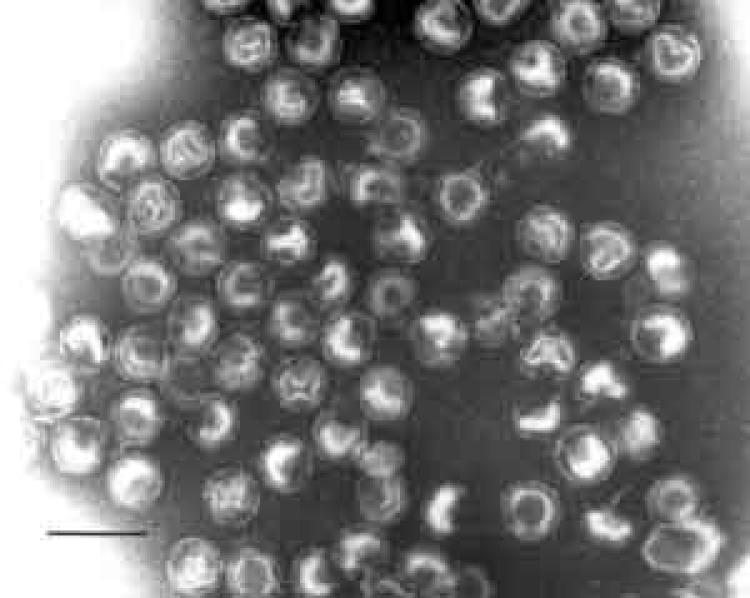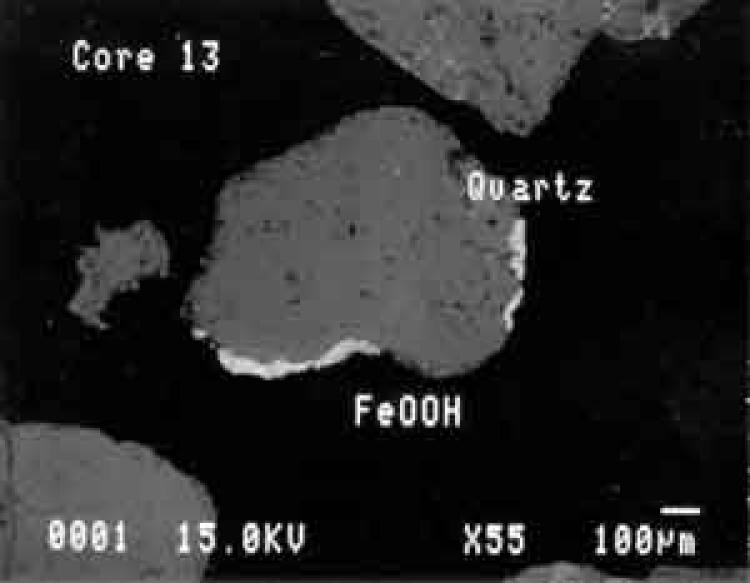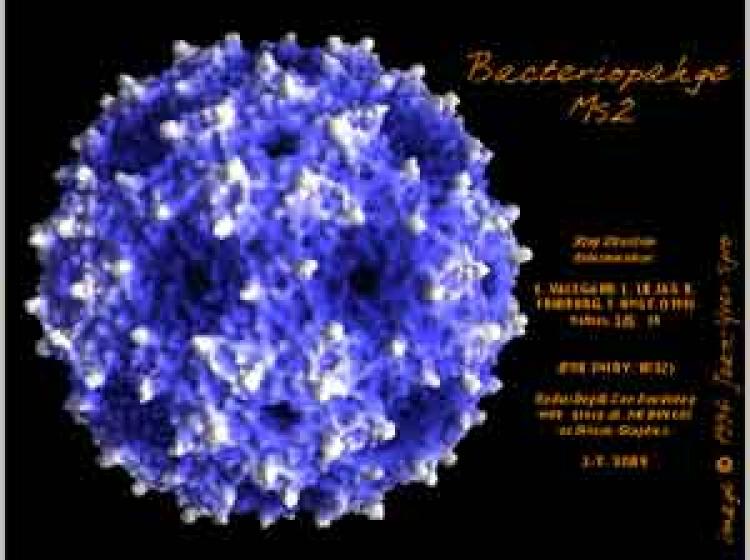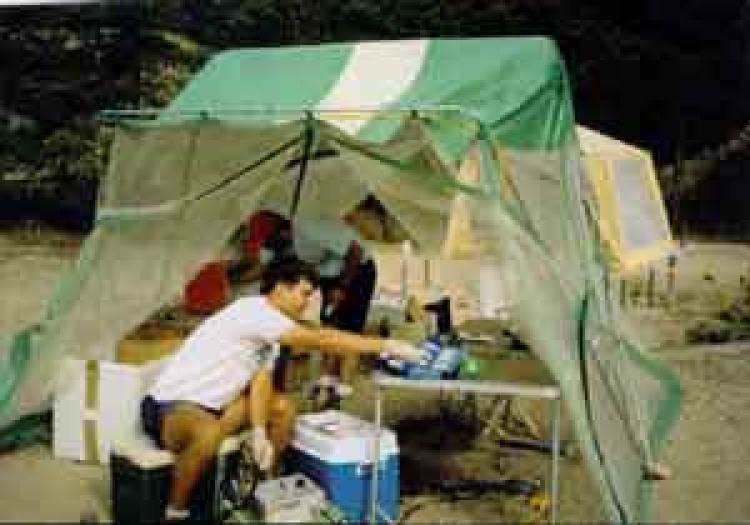Microbe Transport in Saturated Porous Media

Transmission electron microscope image of bacteriophage PRD1, the virus used in most of our research. The scale bar length is 100 nm.
Overview
Since 1994, we have been investigating the transport of viruses in groundwater. This research was motivated by the need to determine the extent of "natural disinfection" occurring in aquifers used as water supplies for the EPA's draft Ground Water Disinfection Rule. Our work has focused on two key aspects of virus transport: attachment and inactivation.
To study attachment, we have used laboratory-scale "static" and flow-through columns (Loveland, 1995; Loveland et al., 1996; Bogatsu, in progress), an intermediate-scale aquifer tank (Aronheim, 1995), and field experiments (Pieper, 1994; Pieper et al., 1997; Ryan et al., 1999). The field experiments were conducted at the U.S. Geological Survey's Cape Cod research site. The aquifer sediment at this site is a ferric oxyhydroxide-coated sand and gravel glacial outwash. The nearby infiltration of secondary sewage effluent created a useful geochemical contrast in the aquifer for testing virus transport -- a sewage effluent contaminated zone and an overlying uncontaminated zone. Our attachment studies have examined the role of solution chemistry and physical and geochemical heterogeneities representative of the Cape Cod site.
Virus inactivation, or "die-off," has been tested in laboratory static columns (Navigato, in progress) and in the field (Pieper, 1994). Current models of virus transport consider only inactivation of viruses suspended in the groundwater. Based on some work done in the late 1970s by Jim Murray and George Parks at Stanford, we hypothesized that the attachment of viruses to the ferric oxyhydroxide coatings could accelerate inactivation significantly. Using the protein capsid/nucleic acid radiolabeling technique devised by Murray and Parks in the lab and in the field, we observed much faster virus inactivation in the presence of Cape Cod sediments.

An electron microprobe image of a thin section of Cape Cod sediment showing the ferric oxyhydroxide (FeOOH) coatings on some of the quartz grains. The scale bar length is 100 micrometers and magnification is 55 times.
Projects
- Groundwater Transport of Viruses
PIs: Joe Ryan, Gary Amy, Ron Harvey, Tissa Illangasekare
National Water Research Institute and
U.S. Environmental Protection Agency, 1993 to 1994 - Virus Attachment, Release, and Inactivation During Groundwater Transport
PIs: Joe Ryan, Menachem Elimelech, and Ron Harvey
U.S. Environmental Protection Agency (R826179-01-0), 1998 to 2000
Collaborators
- Prof. Gary Amy, University of Colorado, Boulder
- Dr. Subir Bhattacharjee, Yale University, New Haven, Connecticut
- Prof. Menachem Elimelech, Yale University, New Haven, Connecticut
- Dr. Ronald W. Harvey, U.S. Geological Survey, Boulder, Colorado
- Prof. Tissa Illangasekare, Colorado School of Mines, Golden, Colorado
- David Metge, U.S. Geological Survey, Boulder, Colorado

A conceptualization of the structure of bacteriophage MS2, another virus used in our research, constructed from x-ray diffraction information.
Students and Theses
- Jeffrey S. Aronheim, MS, 1995. Virus Transport in Groundwater: Modeling of Bacteriophage PRD1 Transport through One-Dimensional Columns and a Two Dimensional Aquifer Tank. Jeff's thesis involved numerous column and tank experiments testing the roles of physical and chemical heterogeneity in virus transport. Two publications are still in progress. Jeff's work was funded by the NWRI/EPA grant.
- Yvonne Bogatsu, PhD, in progress. Effect of Organic Matter, Ferric Oxyhydroxide Coatings, and Blocking on Virus Transport in Groundwater. Yvonne is using laboratory columns to investigate the effect of organic matter and geochemical heterogeneities on the transport of PRD1 in porous media representative of Cape Cod sediments. Her work is supported by the EPA grant and the University of Botswana.
- Jonathan P. Loveland, MS, 1995, Virus Transport in Groundwater: Bacteriophage PRD1 Attachment to Mineral Surfaces.. Jon's thesis investigated the attachment of PRD1 to quartz and ferric oxyhydroxide-coated quartz grains as function of pH. Jon showed that normalizing the extent of virus attachment to the point of zero charge of the grains resulted in very similar attachment behavior. This work was published in Loveland et al. (1996). Jon's work was funded by the NWRI/EPA grant.
- Theresa Navigato, MS, in progress. Effect of Virus Attachment to Ferric Oxyhydroxide-Coated Sand on Inactivation. Theresa's thesis will report the results of experiments examining the inactivation rates of viruses (PRD1 and MS2) in the absence and presence of Cape Cod sediment using a dual-radiolabeling technique to monitor the fate of both the virus capsid and nucleic acid. Her research was funding by the EPA grant.
- Ann P. Pieper, MS, 1995. Virus Transport in Groundwater: A Natural-Gradient Field Experiment in a Contaminated Sandy Aquifer. Annie's thesis reported the results of a summer's worth of field experiments at the U.S.G.S. Cape Cod research site. With the help of undergraduate RAs Patty Li and Brigid Welch, Annie injected and monitored the transport of PRD1 in three experiments. Most of the results are published in Pieper et al. (1997). Annie's work was funded by the NWRI/EPA grant.
- Douglas Vanderbark, BS Independent Study Report, 1995. Virus Transport in Groundwater: Transport of Virus-sized Microspheres in a Contaminated Sandy Aquifer. Along with the viruses injected in Annie Pieper's experiment, some fluorescent polystyrene latex microspheres of different sizes were injected and monitored through the aquifer. Doug calculated relative breakthroughs and collision efficiencies for these microspheres.

Field work at the U.S. Geological Survey's Cape Cod research site. Joe Ryan (foreground) and Dave Metge take samples during Annie Pieper's virus transport experiments, summer 1994.
Publications
(with links to PDF files; some PDF files are large -- 2-4 MBytes)
- Ryan J.N., Elimelech M., Ard R.A., Harvey R.W., and Johnson P.R., 1999.Bacteriophage PRD1 and silica colloid transport and recovery in an iron oxide-coated sand aquifer. Environmental Science & Technology 33, 63-73.
- Ryan J.N., Elimelech M., Ard R.A., and Magelky M.D., 1999. Mobilization and transport of natural and synthetic colloids and a virus in an iron oxide-coated sewage-contaminated aquifer. In U.S. Geological Survey Toxic Substances Hydrology Program – Proceedings of the Technical Meeting, Charleston, South Carolina, March 8-12, 1999 – Volume 3 of 3 – Subsurface Contamination from Point Sources (eds. D.W. Morgenwalp and H.T. Buxton), U.S. Geological Survey Water-Resources Investigation Report 99-4018C, 411-422.
- Metge D.W., Navigato T., Larson J.E., Ryan J.N., and Harvey R.W., 1999. Dual-isotope labeling to monitor virus transport and identifying factors affecting viral inactivation in contaminated aquifer sediments from Cape Cod, Massachusetts. In U.S. Geological Survey Toxic Substances Hydrology Program – Proceedings of the Technical Meeting, Charleston, South Carolina, March 8-12, 1999 – Volume 3 of 3 – Subsurface Contamination from Point Sources (eds. D.W. Morgenwalp and H.T. Buxton), U.S. Geological Survey Water-Resources Investigation Report 99-4018C, 423-430.
- Pieper A.P., Ryan J.N., Amy G.L., Illangasekare T.H., Harvey R.W., and Metge D.W., 1997. Transport of bacteriophage PRD1 through an unconfined sand aquifer: Effect of sewage-derived organic matter. Environmental Science & Technology 31, 1163-1170.
- Loveland J.P., Ryan J.N., Amy G.L., and Harvey R.W., 1996. The reversibility of virus attachment to mineral surfaces. Colloids and Surfaces A. Physicochemical and Engineering Aspects 107, 205-222.
Presentations
- Ryan J.N., 2000. Transport of Viruses, Bacteria, and Protozoa in Groundwater. Environmental Engineering Seminar, University of Colorado, Boulder, October, 2000.
- Bhattacharjee S., Elimelech M., and Ryan J.N., Virus transport in heterogeneous subsurface porous media. Presented at the 74th Colloid and Surface Symposium of the American Chemical Society, Bethlehem, Pennsylvania, June 2000.
- Ryan J.N., Metge D.W., Harvey R.W., Pieper A.P., Navigato T., and Loveland J.P., Is virus inactivation accelerated by attachment to mineral surfaces? Eos Transactions of the American Geophysical Union 80, F104. Presented at the Fall Meeting of the American Geophysical Union, San Francisco, California, December 1999.
- Metge D.W., Navigato T., Ryan J.N., and Harvey R.W., 1999. Role of anionic surfactants in the transport and inactivation of the bacteriophage PRD1 In aquifer sediments: Results of field and laboratory experiments. Presented at the International Symposium on Subsurface Microbiology, Vail, Colorado, August, 1999.
- Bhattacharjee S., Elimelech M., and Ryan J.N., 1999. Modeling virus transport in geochemically and physically heterogeneous subsurface porous media. Presented at the 31st Mid-Atlantic Industrial and Hazardous Waste Conference, University of Connecticut, Storrs, Connecticut, June 1999.
- Ryan J.N., Elimelech M., Ard R.A., and Magelky M.D., 1999. Mobilization and transport of natural and synthetic colloids and a virus in an iron oxide-coated sewage-contaminated aquifer. Presented at the U.S. Geological Survey Toxic Substances Hydrology Technical Meeting, Charleston, South Carolina, March, 1999.
- Ryan J.N., Harvey R.W., Metge D.W., and Larson J.E., 1997. Transport of bacteriophage PRD1 and silica colloids in a sewage-contaminated aquifer. Eos, Transactions of the American Geophysical Union 86, F231. Presented at the Fall Meeting of the American Geophysical Union, December 1997.
- Metge D.W., Harvey R.W., Ryan J.N., and Pieper A.P., 1996. The role of chemical and geochemical heterogeneities upon the transport behavior of viruses, bacteria, and carboxylated microspheres in a sandy aquifer. Presented at the Geological Society of America Meeting, November 1996.
- Ryan J.N., 1996. Effect of Organic Matter on Virus Transport in a Sewage-Contaminated Aquifer. Presented at the 13th Rocky Mountain Regional Meeting, American Chemical Society, Lakewood, Colorado, June 1996.
- Pieper A.P., Ryan J.N., Amy G.L., Illangasekare T.H., Harvey R.W., and Metge D.W., 1995. Effect of linear alkylbenzene sulfonates on the natural-gradient transport of bacteriophage PRD1 through contaminated and uncontaminated zones of an unconfined sand aquifer. Eos, Transactions of the American Geophysical Union 76, F200. Presented at the Fall Meeting of the American Geophysical Union, San Francisco, CA, December, 1995.
- Loveland J.P., Ryan J.N., Amy G.L., and Harvey R.W., 1995. Attachment and release of viruses from mineral surfaces: The role of secondary minimum attachment. Abstracts of Papers of the American Chemical Society 209, 142-ENVR, Part 1. Presented at the 209th National Meeting of the American Chemical Society, April 1995.
- Aronheim J.S., Illangasekare T.H., Ryan J.N., Amy G.L., Harvey R.W., Loveland J.P., and Pieper A., 1994. Biocolloid transport through saturated porous media: A two-dimensional pilot-scale study. Presented at the Conference on Hazardous Waste Remediation, June 1994.
- Loveland J.P., Amy G.L., Harvey R.W., and Ryan J.N., 1994. Effect of chemical perturbations on virus attachment and detachment: Relating kinetics to intersurface potential energy. Abstracts of Papers of the American Chemical Society 207, 172-ENVR, Part 1. Presented at 207th National Meeting of the American Chemical Society, March 1994.
- Ryan J.N., Loveland J.P., Amy G.L., and Harvey R.W., 1993. Effect of (bio)colloid size on the kinetics of detachment from packed bed surfaces. Eos, Transactions of the American Geophysical Union 74, 132. Presented at the Spring Meeting of the American Geophysical Union, May 1993.

